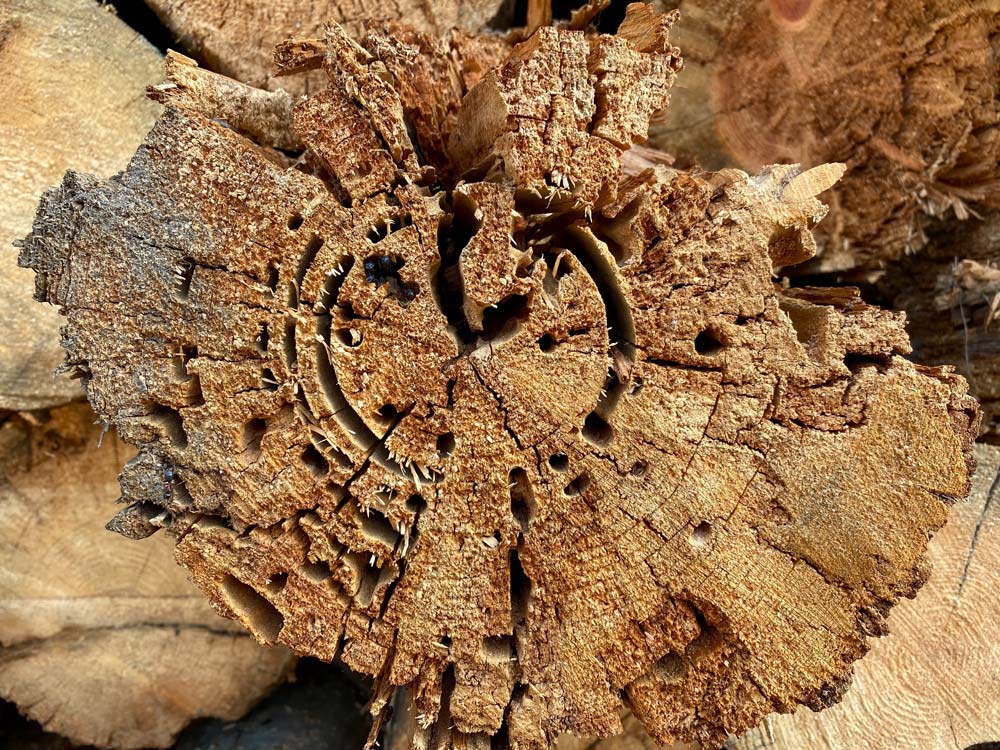What are Carpenter Ants?
These wood-destroying insects get their name from the way that they build their nest. They bore through wood, creating smooth tunnels. Interestingly enough, they don’t actually eat the wood, they simply chew, remove and nest in the wood cavity.
A mature, established carpenter ant colony can contain anywhere from 10,000 to 20,000 worker ants. These workers are born from a single queen who functions as the sole queen for the colony. After approximately 2 years, the queen will produce what is known as “swarmers” who overwinter in the colony and leave the following year. These carpenter ant offspring are active from May until August in the Northeast.
What Do Carpenter Ants Look Like?
Carpenter ants can be anywhere from ½” to ⅝” long, typically quite a bit larger than the average pavement ant. Black carpenter ants are the most common, especially in the Northeast, but they can be a combination of black and red, or completely black, red, or brown. They have six legs, antennae, and a segmented body, much like most ants, sometimes with hair on the abdomen.
Swarming
Carpenter ants will begin mating flights in a process called swarming. Winged males are typically the first to emerge when environmental conditions like temperature and extended daylight signify that it’s time to swarm. If conditions are right, the male releases a pheromone that stimulates the female to leave her nest. The first appearance of winged males in a home should cause homeowners concern, as it signifies that ants are likely nesting inside the house.
Signs Of A Carpenter Ant Infestation
Carpenter ant swarmers are winged ants who leave their current nest to find a suitable place for a new one. These are the large black ants you’ll be most likely to physically see, especially in the spring.

Carpenter ants expel wood shavings, called frass, as they tunnel through wood. These fragments may look like sawdust, but upon closer inspection, you’ll see tiny pieces of ant bodies, or shed wings from the ant swarmers.
With so many ants chewing through the wood framing, it can get noisy! A rustling noise coming from the walls or hollow doors can be a good indication of an infestation. If you knock on a wall or beam and there is a hollow sound, this is cause for concern.
Property Damage
Carpenter ants are not just annoying pests. They can cause significant damage to homes and businesses. While they don’t eat the wood they remove from their nests, these hollow cavities can significantly weaken structures. In the wild, this can cause trees to fall but, in your home, it can mean destabilized support beams or unsafe decks.
Removing and Preventing Carpenter Ants
Carpenter ants require a water source to survive. They typically spend most of their time boring into wood such as fallen trees, dead tree limbs, and rotting logs. However, with a location like a wooden deck, moist basement, garage, or leaky walls, they get both a source of water and protection from the elements.
To prevent carpenter ants in your home, eliminate sources of water and moisture. Ants can use tree branches, bushes, and other plants to access your home. Keeping your property well-groomed and removing overhanging branches can greatly help. Look at entryways to your homes, such as doors and windows, for gaps and cracks. They can fit through incredibly small openings and frequently enter through damaged screens and door gaps that are missing a door sweep. If you use firewood in any capacity for your home, it’s best to keep your reserves away from both your home and any other structures, such as a garage.
When an Exterminator Matters
We recently asked Glenn Olesuk, Owner of Graduate Pest Solutions why carpenter ants are not a pest to try to remove (DIY) on your own:
“A common sentiment expressed by a new carpenter ant customer is that they have already tried to tackle it themselves. ‘Every spring I see a few ants and I’ll buy and spray some (fill in the blank) and they go away but this year they are NOT.’”
The reason for this is because the carpenter ant nests get bigger every year and the number of nestmates goes from in the hundreds to thousands as the years pass. Their spray still kills some but there are many more. A higher volume and better coverage of material are what’s needed.
A good analogy is that you can give me a hammer and a saw but that doesn’t make me a carpenter. I can bang a few nails and cut some lumber but, eventually, I need a carpenter.
One of the reasons our treatments are more successful is that we have high-pressure spray rigs with 300 feet of hose. This enables us to get the necessary reach, volume, and coverage of material around your foundation. The higher spray pressure enables us to successfully treat under low ground cover, vegetation and decks. A typical home will require 4-6 gallons of material for success.”
Experience Sets Us Apart
Graduate Pest Solutions relies on Glenn’s background in Entomology to take care of pests efficiently and effectively while still being safe for you and your family. If you think you have a carpenter ant issue, it’s always a good idea to reach out to Graduate. Estimates are always free and there’s no obligation!
YOU MAY ALSO LIKE
These related articles



